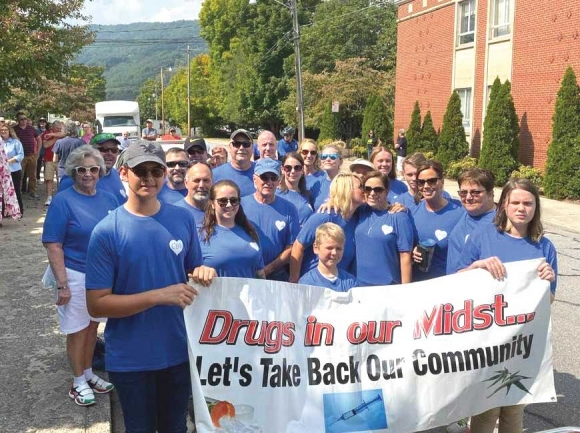Removing the stigma: Spreading Hope and Awareness with the SHARE Project
 Michele Rogers (center) participates in a community prayer walk organized by Drugs in Our Midst, a local program that educates students and community members about substance use. Donated photo
Michele Rogers (center) participates in a community prayer walk organized by Drugs in Our Midst, a local program that educates students and community members about substance use. Donated photo
By Boyd Allsbrook • Contributing writer | “I’m looking for a personal trainer who also knows kickboxing.” An innocuous Facebook recommendation post by an ordinary Waynesville mom. The sort of thing most just scroll past daily without so much as a second glance. But under and behind the normalcy was a cutting need for an outlet to that mother’s unresolved pain.
Michele Rogers does not fit the stereotype of a heroin addict’s mother. Likewise her son, Clay, did not in any way resemble the shadowy criminal figure movies and TV have taught us to see those struggling with substance use disorder as. He grew up in a good Christian home. He played baseball. He was successful, college-educated, kind, and intelligent.
His addiction began with nothing more than the over-prescription of Percocet for a routine outpatient sinus surgery. Two careless refills of the powerful opioid and Clay was hooked. Two careless refills and this bright, promising, young man had fallen into the hell of chemical dependence. When the final prescription ran out, he resorted to buying on the street. Only when he’d spent so much on pills that he couldn’t pay his mortgage did he finally break down and tell his mother.
For the next six years he was in and out of rehab centers. He fought hard to get clean and stay clean, but the horrific symptoms of withdrawal always managed to push him back under. During this interval he was introduced to a cheaper, more potent drug — heroin.
In 2017 he was finally admitted to a long-term recovery center in Greensboro. He stayed sober there for longer than he ever had before. It began to look as if this would be the one. He began to prep for buying an apartment. He fell in love with a girl at church. He was getting his life back, and Michele was overjoyed. At just shy of 11 months free, everyone believed that he was safe enough to leave the facility and live alone.
Addictive neural pathways are deeply ingrained and pernicious. The process of reversing years of opioid dependence can be lifelong in some cases. It took Clay one day after moving into his new apartment to relapse with what he had been told was heroin. But he had been sold fentanyl — a new opioid, both stronger and more deadly than heroin. The dose proved tragically to be fatal. They found his body the following afternoon. He was 29.
Related Items
What does a parent do with that? What can stem the tide of ruined hope and total pain? Rogers did what you’re supposed to do. She went to grief support groups. She grieved. They held Clay’s celebration of life service. She tried to process it all. But the stigma around her son’s disease made things complicated and lonely. Most people weren’t told the circumstances of his death.
To make matters worse, Rogers encountered a serious lack of empathy and understanding at some support groups. Once, when at a meeting, the mother of a cancer victim looked at Michele pointedly and said, “My son did not choose his disease.” This happened three times in one meeting.
“I started crying as soon as we got in the car,” Rogers remembers.
Another time, a group leader asked her if she ever thought about what she might have done differently. It felt like a punch to the stomach. Rogers turned her head away quickly, paused a moment, and responded with, “Only every minute of every day, but thank you for reminding me.”
She needed more. A loved one’s addiction, let alone overdose, is too complex and misunderstood for generalized support.
Enter Lisa Falbo, a local personal trainer. She was recommended to Rogers by multiple mutual friends. Serendipitously, her gym was just a block away from Rogers’ office. When they met, Rogers told her son’s story and said that she had come to Falbo in hopes that aggressive physical fitness could channel her pain. What she couldn’t have predicted was that both of Falbo’s sons were struggling with substance use disorder as well.
“We were like, wow, this is really meant to be,” said Rogers.
The two women began working out together. They kickboxed — Rogers enjoyed throwing heavy medicine balls around the room. They found true empathy in each other’s company. Together, they began working through the complex emotions of loneliness, shame, fear, and sadness valent with parenting — and losing — an addicted child.
Lisa’s oldest son, Sam, had been roped into the world of drugs at the young age of 16 through what she refers to as “good old-fashioned peer pressure.” He, like so many do, fell in with a bad crowd during high school. He started with marijuana, progressed quickly to pills, and ended with heroin.
Falbo was quick to note that her son’s addiction was not about “choice.”
“Back up to yourself when you were 16 years old, and you were offered that first drink. Or 17 years old and offered that first pill. That choice. At that age do you really think about the ramifications of what that’s gonna look like down the road?” she said.
“The human brain doesn’t fully develop until, what, 25?” Rogers added.
A large part of addiction’s stigma is based on the notion that an addict can simply reject the first substance offered. That they are somehow culpable. Some would be tempted to call Clay’s story a tragedy but condemn Sam for poor judgement. Rogers and Falbo want you to know that’s not the case.
Sam was a good kid who happened to have what Falbo calls the addictive “gene.” For people like him, normally harmless acquiescence to peer pressure can be devastating. It only takes one time for the addiction’s seed to be planted. And the Reagan-era “just say no!” campaign does not cut it as a cure-all preventative measure.
Like Clay, you’d never have suspected that Sam was an addict. A creative type, he was a talented knife maker, and built a successful business on that skill. He fought addiction his entire adult life and was intermittently sober with the help of medication. When he tried to get clean of even the medication, his life began to spiral again. He had assumed too early that he was cured. Without the medication-assisted therapy, he suffered a full backslide into addiction. This relapse pushed him back into the old bad crowd. He was arrested for minor possession and sent to jail for nine months — a harsher sentence due not to criminal behavior, but mere missed court dates.
“If you’re in the throws of addiction, what’s a court date to you?” Falbo said.
A chemical detox in jail is not a pleasant experience, but Sam bore through it all and did his time well. Upon release, he found himself alone in a cold and substance-less world. Old friends and acquaintances looked at him with suspicion. He now was branded with the identity of drug addict. He had no job, no clear way forward. It proved too much to handle.
Very commonly, addicts who detox in captivity lose tolerance for their substance of choice. Such was the case with Sam. Within a week of his release, he fatally overdosed at the age of 27.
Falbo was heartbroken, but together with Rogers strove to channel her grief into action. They worked out still. They talked. They cried. In the midst of it all, a plan was forming. They were guided by one sobering fact — that for family members of addicts, there was nothing in Haywood County. Most parents are not lucky enough to stumble across one another. Most never find the vital empathy and support requisite for true healing.
“It’s hard to talk about,” said Rogers. “It’s not like you just say, hey, gee, my son’s addicted to heroin, do you have any advice for me? Most of my friends never knew.”
This fear of social condemnation can be deadly. Reticence to reach out only deepens the isolation of addiction. Both women are driven by a knowledge that opioid addiction is widespread in the community and that too many families are suffering in silence right now.
Together, they’ve started The SHARE Project: a comprehensive support system for families of those battling substance use disorder. The acronym stands for Spreading Hope and Awareness and Removing the Epidemic stigma. They host support and grief groups for parents, brothers, and sisters. They provide vital information about resources an addict has in Haywood county and the surrounding areas. They’re determined to help other young people avoid their sons’ fate.
“If we can help just one mother, one child,” said Rogers, “It will be worth it.”
If you or a loved one are struggling with SUD, The SHARE Project wants you to know that you’re not alone. They want you to know that there are resources available, and that there is hope. If you’re lucky enough to have never been touched by addiction, Rogers and Falbo invite you to consider what lies behind the innocuous. How many Facebook want-ads hide heartbreak? Which neighbors’ “normal” sons and daughters are battling heroin, Percocet, and fentanyl in silence? Who have you let hear harsh words about some faceless addict, and in so doing dissuaded from getting help?
Stigma is passive judgement, the assurance that all who struggle with a given issue are somehow “other.” Addiction does not discriminate. It’s everyone’s problem to solve — and it begins with a little understanding.
For more information, follow The SHARE Project on Facebook.













